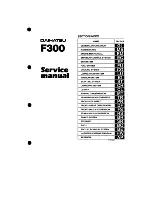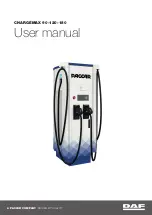
Driving on wet roads
Aquaplaning
If water has accumulated to a certain depth on
the road surface, there is a danger of aquaplan-
ing occurring, even if:
R
you are driving at low speeds
R
the tyres have adequate tread depth
For this reason, drive in the following manner in
the event of heavy rain or in conditions in which
aquaplaning can occur:
R
lower your speed
R
avoid tyre ruts
R
avoid sudden steering movements
R
brake carefully
Driving on flooded roads
!
Bear in mind that vehicles travelling in front
or in the opposite direction create waves. This
may cause the maximum permissible water
depth to be exceeded.
These notes must be observed under all cir-
cumstances. You could otherwise damage
the engine, the electronics or the transmis-
sion.
If you must drive on stretches of road on which
water has collected, please bear in mind that:
R
in the case of standing water, the water level
must be no higher than the lower edge of the
vehicle body
R
you should drive no faster than walking pace
Winter driving
G
WARNING
If you shift down on a slippery road surface in
an attempt to increase the engine's braking
effect, the drive wheels could lose their grip.
This increases the risk of skidding and having
an accident.
Do not shift down for additional engine brak-
ing on a slippery road surface.
G
DANGER
If the exhaust pipe is blocked or adequate
ventilation is not possible, poisonous gases
such as carbon monoxide (CO) may enter the
vehicle. This is the case, e.g. if the vehicle
becomes trapped in snow. There is a risk of
fatal injury.
If you leave the engine or the auxiliary heating
running, make sure the exhaust pipe and area
around the vehicle are clear of snow. To
ensure an adequate supply of fresh air, open a
window on the side of the vehicle that is not
facing into the wind.
Have your vehicle winterproofed at a qualified
specialist workshop at the onset of winter.
You should drive particularly carefully on slip-
pery road surfaces. Avoid sudden acceleration,
steering and braking manoeuvres. Do not use
cruise control or Distance Pilot DISTRONIC.
If the vehicle threatens to skid or cannot be
stopped when moving at low speed:
X
Vehicles with manual transmission: shift
to neutral.
X
Vehicles with automatic transmission:
shift the transmission to position N.
X
Try to bring the vehicle under control by using
corrective steering.
The outside temperature indicator is not
designed to serve as an ice-warning device and
is therefore unsuitable for that purpose.
Changes in the outside temperature are dis-
played after a short delay.
Indicated temperatures just above the freezing
point do not guarantee that the road surface is
free of ice. The road may still be icy, especially in
wooded areas or on bridges.
You should pay special attention to road condi-
tions when temperatures are around freezing
point.
Further information on driving with snow chains
(
Y
page 337).
Further information on driving with summer
tyres (
Y
page 336).
Observe the notes in the "Winter operation" sec-
tion (
Y
page 336).
172
Driving tips
Dri
ving
an
d
pa
rki
ng
















































